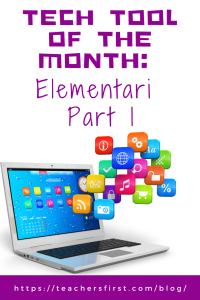Elementari is a colorful and engaging website that allows you to easily create digital stories as slideshows. The tool features various fonts, speech bubbles, animation, backgrounds, voice audio options, and drag-and-drop images. The site provides step-by-step instructions to help navigate the many features. Share your story using the provided URL (there is also an option to embed). The free teacher account allows for one class with 35 students. Students can join using a code rather than email. Teachers must approve student stories before they are published. Elementari is ideal for blended, flipped, and remote learning, as presentations can be shared using a URL. There is also a curriculum guide for additional ideas, plus many other educational resources, on the Educators page.
Applying the Triple E Framework
The Triple E Framework, created by Dr. Liz Kolb, believes that “effective technology integration begins with good instructional strategies and not fancy tools” (tripleeframework.com). Dr. Kolb wrote a book on the topic, Learning First, Technology Second (ISTE, 2017), that lays out the three main uses for technology in education: to Engage, Enhance, or Extend learning goals. We can use this framework to decipher why we use specific classroom tools. Here is a rubric based on the Triple E Framework you can use to evaluate whether Elementari (or any other technology) is a good fit with your learning goals and whether you should use it in your lesson.
- Engage in learning goals: When students interact with a teacher-created presentation, they focus more on the task because they are working at their own pace. In addition, there are no badges, games, or other extras in Elementari to distract students from the learning process. Likewise, students are more engaged as they create digital stories in Elementari by incorporating images, voice narration, and text representing content learning goals (for example, a slideshow related to the Periodic Table in chemistry).
- Enhance learning goals: When students view Elementari presentations created by others, they are using technology to connect and understand concepts and ideas. Creating slideshows enhances learning goals by enabling students to share questions, images, and information. In addition, it allows students to demonstrate a more sophisticated understanding of the topic by creating original work. Students use higher-order thinking skills by organizing their thoughts for projects.
- Extend learning goals: Dr. Kolb describes extended learning as an opportunity for students to learn, connect, and collaborate outside the regular school day and as a bridge between the school day and real-life experiences. Whether students use this tool to view a slideshow created by others or create their own, Elementari would fit nicely with flipped, blended, and remote learning. Students could also work collaboratively on projects outside of traditional class time. Elementari allows students to practice skills they need to become college and career-ready; this includes the ability to use technology and collaborate on work-related projects.
SAMR Connection
The SAMR Model, by Dr. Ruben Puentedura, suggests that technology implementation has four levels. Therefore, we can use this model as a guideline to analyze how we use technology tools in the classroom. For example, using Elementari can be at the Substitution, Augmentation, Modification, and Redefinition levels, depending on what the student is doing.
- Substitution: The substitution level is the most basic level of SAMR and refers to when technology acts as a direct substitute without any functional improvements. Two quick examples of this could be if students were viewing a basic slideshow that a teacher created or if students created their own simple slideshow (about a character from a story) by just adding pictures on slides instead of stapling hand-drawn pages together.
- Augmentation: At the level of augmentation, the technology acts as a direct substitute and includes some functional improvements. We could take the character slides activity to the level of augmentation by having students use Elementari to add images, choose the speech bubble type, and change fonts. Without technology, these changes would be much more difficult, if not impossible, without having to start over.
- Modification: The level of modification allows us to make (or modify) the activity into something more integrated with technology, meaning there is significant task redesign. Using the same story character slides activity, we could move to the level of modification by adding voice narration recordings and having students share the link to their presentation with their teacher or classmates.
- Redefinition: At the highest level, the technology allows for creating previously impossible new tasks. Returning to our example of the story character slides activity, we could get to the level of redefinition by having your class share the slideshows (by URL) with parents using a class wiki page or by having the class create and share a Google Site with all of the slideshows.
Please take advantage of Part 2 of the Tech Tool of the Month: Elementari, where we’ll discuss using the tool and classroom ideas. In the meantime, let us know how you have used Elementari in your education setting in the comment section below.


